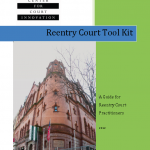August 25, 2014
Early on, I came to see the drug court as just a part of the solution to misbehavior and criminal conduct. I saw community generated and sustained programs as being at the heart of real criminal justice reform, and drug court being the first true “Community Court”. By the time I got to Washington to set up NADCP in 1996, a small offshoot of drug court, called “Community Court” had been established in the heart of Manhattan, as part of a campaign to clean up the Times Square area. Organized by a New York State sponsored reform organization, the Center for Court Innovation, and with the support of financial institutions in the Times Square area, it had adopted the community court label for a court dealing with minor infractions and misdemeanors, that were committed mostly by derelicts and homeless people (whose very presence discouraged family tourism, a major goal of the programs backers). The program worked and remains a thriving and effective neighborhood based variation on drug court with fifty “Community Courts” or more across the nation.
Knowing the importance of names and the meaning we give them, I belatedly attempted to establish the broader community roots of drug courts by dedicating the 2nd Annual NADCP Conference in 1997 to an all inclusive concept of “Community Courts’, that included drug courts and other community based programs being developed across the nation. I wrote and distributed a concept paper entitled “Introducing The Community Court Institute”, (an early precursor of the hugely successful “National Drug Court Institute”) that was distributed at the national conference. I argued in a letter to Shay Bilchik, on September 26, 1996, (the Administrator of the Office of Juvenile Justice and Delinquency Programs) who was leading the Justice Departments project to define “Community Court”, that they should be described as a “Neighborhood Court” since they “are designed to reflect neighborhood concerns”
Unfortunately, the community court definition as a neighborhood court dealing with minor offenses was too well established to be dislodged. The result; many drug courts and their progeny never saw their programs as community based, relying on community participation, or being responsible to their communities; a problem that continues in many drug courts and similar programs to this day. In time I settled for the designation of Community-Based Court as being a substitute for the all inclusive Community Court label. But I have always regretted the lost opportunity to stamp Drug Court and its progeny as “community courts”
…………………………………………………………………


